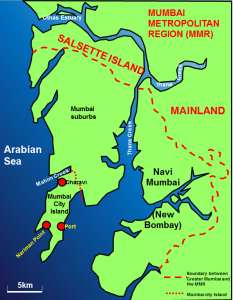Southern slums are framed conceptually as potential sites for capital reinvestment in current gentrification debates (Lees, Shin and López Morales 2016). In other words, mega-displacement and slum demolition projects are increasingly under the label of gentrification and performed by the logics of switch capital, which absorbs the surplus capital by constructing the built environment. The key questions are whether gentrification lens is a plausible concept understanding and describing displacements in “non-privatized tenure regimes” in Mumbai (Ghertner 2015), and how the power is materialized by different actors (Lees, Shin and López Morales 2016).
These questions are helpful to “decolonize the gentrification literature” (Ghertner 2014), and avoid prioritizing the Anglophone world as site of theory production. I quote from Roy at length:
“theories have to be produced in place (and it matters where they are produced), but that they can then be appropriated, borrowed, and remapped” (Roy 2009).
What Roy is describing here is that Mumbai can act as an important source of theories production while remaining sensitive to its geographically and historically specific effects (read: place). Similarly, Ghertner (2015) critiques using Southern cities to affirm theory from “here”, the global North.
Slum gentrification is not a “property market expansion” (Ghertner 2015), which presumes that gentrification takes place in “well-estabilish property-centrism” (Ghertner 2014). Instead, the displacement processes are happening in the diverse tenures, mostly without legal land titles. This type of gentrification, one the one hand, converts the land tenure from informal to formal, on the other hand, creates the opportunity for “occupancy without ownership” (Ghertner 2015). This juristic loophole allows migrants to claim the ownership where they have settled earlier and restrict the access of capital in pricing out initial residents.
Slum demolition is not simply a beautification of city because of the slums’ “pro-poor agglomeration economies clustering” function (Ghertner 2015). This clustering function enables different scale of manufacturing companies, level of class groups and skill labours complete their jobs effectively within a spatial close proximity (Ghertner 2015). Dismantling slums without a proper understanding and manner will disintegrate this spontaneous economic and social organizations. Although the government and developers can yield huge amount of revenue in a short time, wreck of slums and expulsion of the dwellers will lead to social and economic crisis.
The key actors in unfolding their power are several. The scheme designers provide public housing to the “legitimate poor”, land revenue for the local government, an “elite-biased world-class urban aesthetic” for the middle-upper classes, redevelopment profits for developers and transnational capital (Lees, Shin and López Morales 2016). Meanwhile, the design of the authority of redevelopment help offset political obstacles posed by the grassroots through legal channels. The example of mega-project like the slum redevelopment project in Dharavi (DPR) will be mentioned later.

Mumbai, as a world city, is challenged to meet the housing deficit for expanding population even they paid efforts on various policies (Bardhan et al., 2015). The city houses the largest slums in Asia. The most notable one is Dharavi, which lies in the center of the city where one million squatters live in temporary housing on one square mile of land besides the latest and high-priced commercial developments. According to Census 2001, more than 50% of the city’s population lived in the slums.
References
Bardhan, R., Sarkar, S., Jana, A., & Velaga, N. R. (2015). Mumbai slums since independence: Evaluating the policy outcomes. Habitat International, 50, pp. 1-11. doi:10.1016/j.habitatint.2015.07.009
Ghertner, D.A. (2014). India’s urban revolution: Geographies of displacement beyond gentrification. Environment and Planning A, 46(7), pp. 1554–1571. doi: 10.1068/a46288.
Ghertner, D. A. (2015). Why Gentrification Theory Fails In ‘Much Of The World’. City 19(4), pp. 552-563. doi: 10.1080/13604813.2015.1051745.
Gamesby, R. (n.d.). Map of Dharavi. [image] Available at: http://www.coolgeography.co.uk/A-level/AQA/Year%2013/World%20Cities/Mumbai/Mumbai.htm [Accessed 3 Mar. 2017].
Lees, Loretta, Hyun Bang Shin, and Ernesto López Morales. (2016). Planetary Gentrification. 1st ed. Cambrige: Polity Press.
Roy, A. (2009). The 21st-century metropolis: new geographies of theory. Regional Studies, 43(6). pp.819-830. doi: 10.1080/00343400701809665.